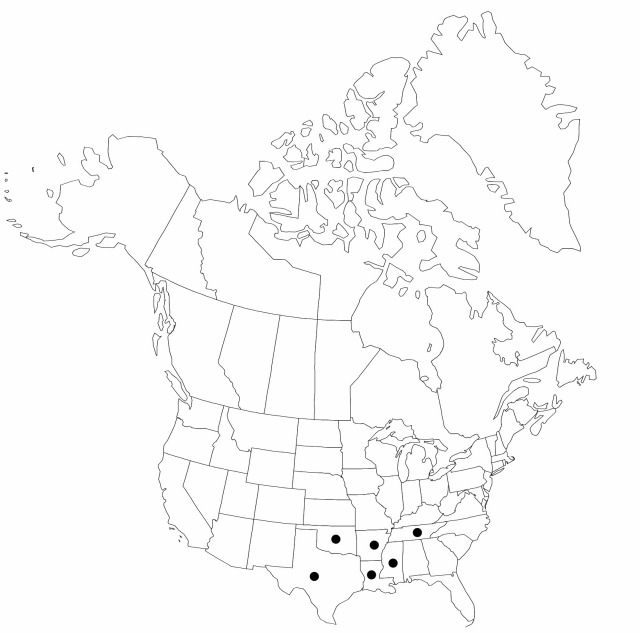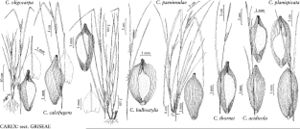Difference between revisions of "Carex bulbostylis"
Bull. Torrey Bot. Club 42: 617. 1915.
FNA>Volume Importer |
FNA>Volume Importer |
||
| Line 11: | Line 11: | ||
|name=Carex amphibola var. globosa | |name=Carex amphibola var. globosa | ||
|authority=(L. H. Bailey) L. H. Bailey | |authority=(L. H. Bailey) L. H. Bailey | ||
| − | }}{{Treatment/ID/Synonym | + | }} {{Treatment/ID/Synonym |
|name=Carex grisea var. globosa | |name=Carex grisea var. globosa | ||
|authority=L. H. Bailey | |authority=L. H. Bailey | ||
| Line 29: | Line 29: | ||
|elevation=30–300 m | |elevation=30–300 m | ||
|distribution=Ark.;La.;Miss.;Okla.;Tenn.;Tex. | |distribution=Ark.;La.;Miss.;Okla.;Tenn.;Tex. | ||
| − | |discussion=<p>Carex bulbostylis is common within much of its rather narrow range. It often occurs with C. amphibola and C. planispicata.</p> | + | |discussion=<p><i>Carex bulbostylis</i> is common within much of its rather narrow range. It often occurs with <i>C. amphibola</i> and <i>C. planispicata</i>.</p> |
|tables= | |tables= | ||
|references= | |references= | ||
| Line 54: | Line 54: | ||
|publication year=1915 | |publication year=1915 | ||
|special status= | |special status= | ||
| − | |source xml=https://jpend@bitbucket.org/aafc-mbb/fna-data-curation.git/src/ | + | |source xml=https://jpend@bitbucket.org/aafc-mbb/fna-data-curation.git/src/8f726806613d60c220dc4493de13607dd3150896/coarse_grained_fna_xml/V23/V23_835.xml |
|genus=Carex | |genus=Carex | ||
|section=Carex sect. Griseae | |section=Carex sect. Griseae | ||
Revision as of 17:11, 18 September 2019
Plants densely cespitose; rhizome internodes 1.6–2.2 mm thick. Culms strongly purple-red to 3–7.4 cm high at base, 10–65 cm. Leaves: sheaths glabrous; blades green, widest blades 2.2–3.5(–3.9) mm wide, smooth abaxially. Inflorescences 0.31–0.94 of culm height; peduncles of lateral spikes barely scaberulous or smooth; peduncles of terminal spikes 1.8–28 mm, usually slightly exceeding lateral spikes; proximal bract sheaths tight, abaxially glabrous, sheath front convex, elongated 0.3–1.1(–1.7) mm beyond apex; ligules 0.4–2.2 mm; distal bract usually much exceeding terminal spike. Spikes 4–5, widely separate or distal 2–3 spikes overlapping; lateral spikes pistillate, with (1–)3–9(–11) perigynia, 4–19 × 5.1–8.2(–10.2) mm, ratio of spike length (in mm) to flower number = 1.4–1.9; terminal spikes (7–)10–29 × 1.1–2.1(–3.1) mm. Pistillate scales 2.8–5.4 × 1.7–2.5 mm, margins whitish, entire, apex with awn 0.8–2.6 mm. Staminate scales 3.6–5 × 1–1.8 mm. Anthers 2.9–3.7 mm. Perigynia distichously imbricate, 51–67-veined, inflated, unwrinkled, oblong-obovoid, orbicular or suborbicular in cross section, 3.6–4.4 × (1.8–)2–2.5(–2.8) mm, 1.6–2(–2.1) times as long as wide, dull, base very gradually tapered, apex abruptly contracted; beak straight, 0–0.2(–0.3) mm. Achenes obovoid, 2.6–3.3 × 1.6–2.1 mm, loosely enveloped by perigynia; stipe straight, 0.3–0.7 mm; beak straight, 0.05–0.3 mm.
Phenology: Fruiting spring.
Habitat: Mesic deciduous forests, on flood plains and low on slopes just above flood plains, usually in calcium-rich loams and clay-loams
Elevation: 30–300 m
Distribution

Ark., La., Miss., Okla., Tenn., Tex.
Discussion
Carex bulbostylis is common within much of its rather narrow range. It often occurs with C. amphibola and C. planispicata.
Selected References
None.
